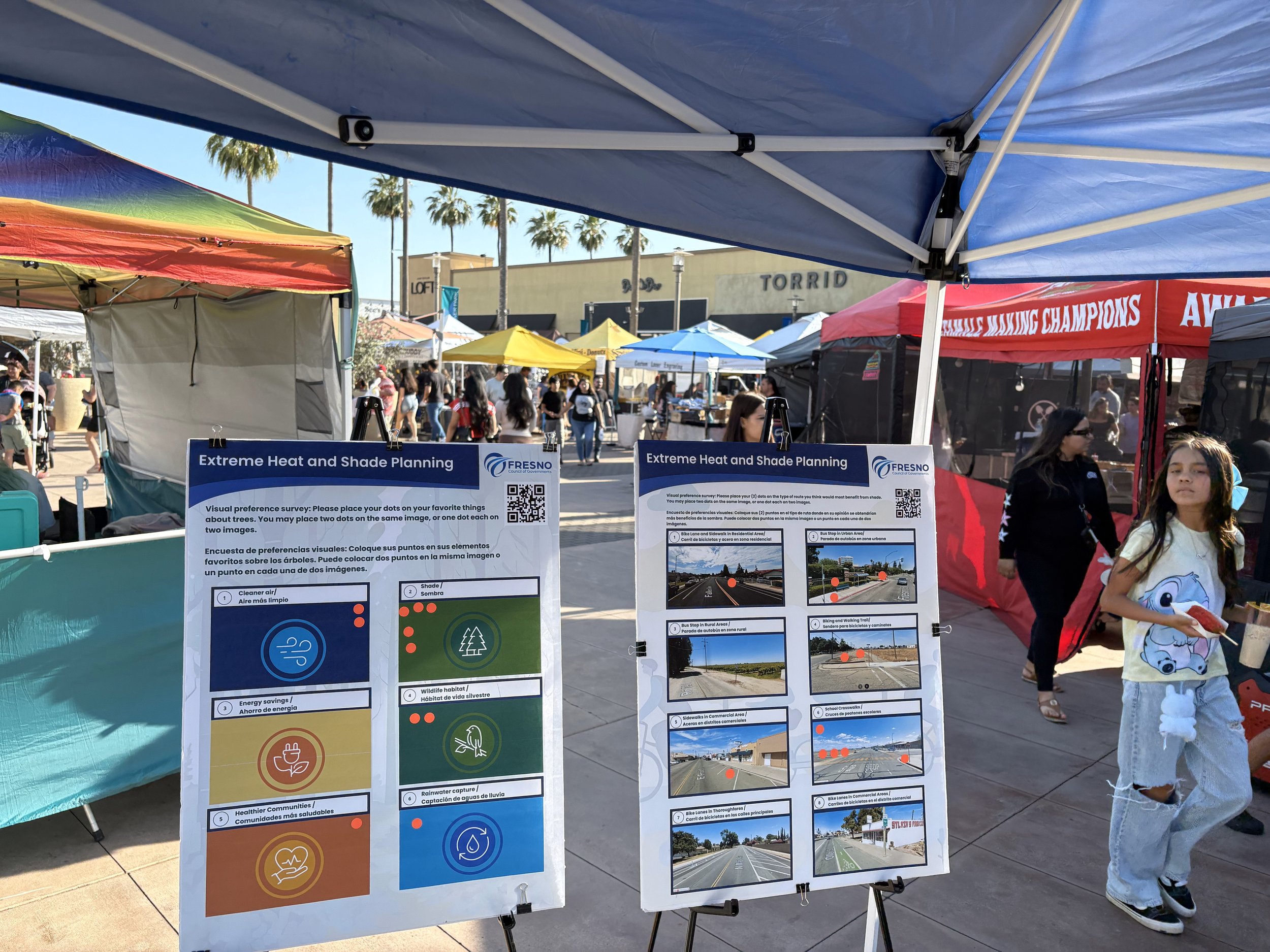
Public Outreach
VRPA Technologies offers services for creating and building partnerships, supporting the exchange of ideas and information among interested individuals and groups and resolving conflicts and challenges.
Services Offered:
Public Outreach and Education Programs for Transportation Projects (all modes)
Public and Stakeholder Meetings, Hearings, Workshops & Interviews
Meeting Facilitation
Speakers’ Bureau
Partner Agency and Technical Presentations
Door-to-Door Contact (Business and Resident)
Focus Groups
Public Service Announcements
Project Branding and Websites
Radio, Newsprint, and Online Advertising
Educational Videos, Surveys and Questionnaires
Projects
-
The California High-Speed Rail Authority and project designer Stantec Consulting Services, Inc. (Stantec) are currently working to advance design and finalize the approximately 33.9-mile Merced to Madera project configuration footprint. These critical steps will move the sections closer to construction, with the goal of electrified high-speed trains running between Merced and Bakersfield between 2030 and 2033. Public outreach services for this project are being led by VRPA, in coordination with Stantec, and California High-Speed Rail Authority staff. VRPA, under Stantec’s direction, is also assisting with irrigation district, agency, and utility owner relocation design reviews and coordination.
VRPA’s public outreach involvement on this project includes the following:
Maintaining and updating the stakeholder database
Participation in monthly public outreach status meetings, and bi-weekly interdisciplinary meetings
Preparation of the Public Outreach and Communication Strategies document
Development of a property access training program, and facilitation of related training sessions for Stantec Team members accessing property along the planned High-Speed Rail corridor
Co-facilitation of two (2) Farm Bureau meetings
Participation in informational workshops in Merced and Chowchilla
Oversaw the distribution of property owner noticing flier, and workshop noticing flier
*Photo Credit: California High-Speed Rail Authority
-
The Fresno Council of Governments (Fresno COG) is conducting an Extreme Heat Analysis and Shade Adaptation Plan to address extreme heat in Fresno County, with a focus on residents that rely on walking, bicycling, and public transit. This initiative includes an extreme heat vulnerability analysis to identify priority areas for projects based on risk and exposure factors. The vulnerability analysis will examine factors such as transit dependency, projected temperature increases, existing health conditions, current tree canopy coverage, socioeconomic factors, and pedestrian/bicyclist traffic patterns. The project, launched in early 2025, is expected to be completed by the end of 2026. Once finalized, the plan will inform General Plans and other long-range planning documents across Fresno County, while also guiding the design of future transportation infrastructure. It will identify specific tree canopy and vegetative cover projects that can be incorporated into future capital improvement projects, with local jurisdictions able to apply for funding to implement these recommendations. Public outreach and transportation analysis services for this study are being led by VRPA, in coordination with DUDEK and Fresno COG staff.
VRPA’s involvement on this project includes the following:
Development of the Public Engagement Plan.
Identification of working group members and stakeholders.
Participation in working group meetings, material preparation, and meeting presentations.
Organization and participation in bilingual pop-up events, virtual workshops, and visual preference surveys.
Social media and email blasts to communicate about the project.
Developing the methodology for pedestrian and bicycle traffic analysis.
Supporting the development of criteria to prioritize the five most important vulnerable active transportation corridors for near-term action based on technical analysis and public input.
Assisting with presentations made to Fresno COG’s Transportation Technical Committee (TTC), Policy Advisory Committee (PAC), and Policy Board.
-
VRPA provided outreach and communications services to enhance public outreach by facilitating public engagement for transportation planning activities for the Department of Transportation (Caltrans) across the State. VRPA and its sub-consultants worked together with Caltrans Headquarters and various Caltrans Districts to prepare public engagement tasks and cost proposals for transportation planning and engineering projects and carrying out the tasks outlined.
Efforts included the SR 99 Soundwall Project, State Route 20 Aesthetic Corridor Master Plan, the I-5/SR 99 Goods Movement and Truck Corridor Study, the SR 255 Engineered Feasibility Study, the US 101/Broadway Engineered Feasibility Study, the Pacific Coast Bikeway Plan in Mendocino County, the SR 12 Corridor Study, the Housing Siting, Air Quality and Health Roundtable, the California Household Travel Survey, the California Freight Mobility Plan Focused Group Outreach, the Transportation Planning and Programming Public Outreach Activities Phases I & II, Capital City Freeway (E Street) Transition Lane Project, District 12 Managed Lanes Feasibility Study/Project Study Report – Project Development Support Public Participation Plan and Early Outreach Activities, State Route 9 Planning in Santa Clara County, State Route 1 Scott Creek Lagoon Restoration and Bridge Replacement Project Phase I Stakeholder Engagement, and the Strategic Working Sessions on MAP 21 Performance Measures and Implementation.
-
The Transportation Network Vulnerability Assessment (TNVA) will identify transportation assets that may be vulnerable to impacts of climate change, such as extreme heat or precipitation, and assess how to address those risks with various projects and strategies. Public engagement services for this project are being led by VRPA, in coordination with WSP USA Inc. (WSP) and Merced County Association of Government (MCAG) staff. VRPA, under WSP’s direction, is also assisting with developing a set of recommended adaptation strategies to address transportation-related climate vulnerabilities, and will also be providing cost estimates for the adaptation options that WSP will use in the cost-benefit analysis.
Image source: MCAG
-
VRPA Technologies, Inc. was retained as a contractor to assist with implementation of a public outreach and education program related to California High-Speed Trains in the Central San Joaquin Valley. VRPA was responsible for helping to design the outreach program prior to the vote on Proposition 1A in November 2008. VRPA presented information regarding the system to over 40 different stakeholder groups. In addition, VRPA was responsible for development of the Scoping Workshop for the HST Environmental Impact Report/Statement (EIR/EIS) conducted in March 2009. VRPA prepared an outreach list with over 4900 contacts including elected officials and stakeholders from Fresno, Kern, Kings, Madera, and Tulare Counties. VRPA continued to assist the Segment 6 team with outreach activities that led toward development and certification of the EIR/EIS.
-
The State Route (SR) 99 Comprehensive Multimodal Corridor Plan (CMCP) is focused on identifying a broad range of multimodal opportunities for improving and enhancing the SR 99 corridor, and developing a stakeholder shared vision and implementation plan for the corridor that aligns with State goals to reduce greenhouse gas (GHG) emissions and passenger vehicle miles traveled (VMT), and increase freight reliability and throughput for inclusive economic development. The development of the SR 99 CMCP is being led by the Jacobs Engineering Team, in coordination with California Department of Transportation (Caltrans) Districts 6, 10, and 3, building from efforts by all three Districts, and drawing upon a rich inventory of previous and active planning efforts at the State, regional, and local levels. Public outreach services are being led by VRPA, in coordination with Jacobs Engineering and Caltrans staff.
VRPA’s involvement on this project includes the following:
Maintaining and updating the listing of stakeholder contacts identified for engagement
Development of a Public Outreach and Engagement Plan (PEP)
Preparation of engagement activity materials, including flyers, brochures, PowerPoint slides, maps, and photographs.
Attendance and participation in SR 99 CMCP Technical Advisory Committee (TAC) meetings
Development of informational project videos
Preparation of public engagement summary reports






